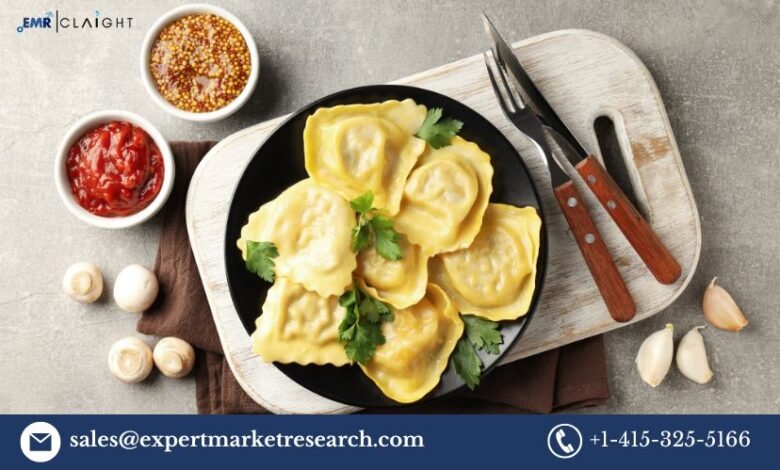Pre Made Ravioli Manufacturing Plant Project Report 2025: Detailed Setup, Machinery, and Market Insights
Pre Made Ravioli Manufacturing Plant Project Report 2025

Introduction
The global demand for quick and convenient food options has surged over the years, and pre-made ravioli is among the most popular choices. This pasta dish, typically filled with cheese, meat, or vegetables, is a favorite in both households and foodservice establishments due to its ease of preparation and versatile flavor profile. Pre-made ravioli manufacturing has become a profitable business venture as consumers look for high-quality, ready-to-eat meal solutions that save time without compromising on taste. This Pre Made Ravioli Manufacturing Plant Project Report will provide an overview of setting up a Pre-Made Ravioli Manufacturing Plant, covering aspects like market demand, raw materials, production processes, machinery, financial considerations, and regulatory requirements. By understanding these key components, entrepreneurs can assess the potential for success in the ravioli manufacturing industry.
Market Overview
The market for pre-made ravioli is expanding, driven by several factors:
- Busy Lifestyles: As people become busier, the demand for convenient, ready-to-eat meals has increased. Pre-made ravioli offers a quick, easy solution for busy families, young professionals, and individuals seeking an alternative to home-cooked meals.
- Growing Demand for Italian Cuisine: Italian food has a global appeal, and ravioli, being one of the most popular Italian dishes, is in high demand worldwide. This is especially true in regions with a growing middle class and international food markets.
- Health-conscious Consumers: Many consumers are becoming more health-conscious and seeking fresh, high-quality frozen food options. Pre-made ravioli manufacturers are increasingly incorporating healthier ingredients and offering organic or gluten-free options to cater to this market.
- Foodservice Industry Growth: Restaurants, cafes, and catering services rely on pre-made ravioli to serve customers quickly without compromising on quality. This segment is growing, especially in urban areas and regions with a strong dining-out culture.
The market’s future looks promising, with rising consumer preference for convenience, quality, and varied options fueling demand for pre-made ravioli.
Get a Free Sample Report with Table of Contents@
Business Plan and Feasibility Study
Setting up a pre-made ravioli manufacturing plant requires careful planning, market analysis, and financial feasibility assessments. Here are some essential steps:
1. Market Analysis
- Demand Assessment: Understand the demand for pre-made ravioli in your target market, including geographic regions and consumer preferences. Identify the key drivers of demand, such as busy lifestyles, growing culinary trends, and preferences for Italian cuisine.
- Competitor Analysis: Analyze the competitive landscape. Look at both local and international manufacturers of ravioli, their product offerings, pricing, and distribution strategies.
- Pricing Strategy: Determine competitive pricing that reflects the quality of your product, operational costs, and target market. Pricing may vary based on ingredients, packaging, and portion sizes.
2. Location and Facility Setup
- Proximity to Raw Materials: Choose a location that is close to suppliers of raw materials, such as flour, fillings (cheese, meat, vegetables), and packaging materials. This can reduce transportation costs.
- Market Accessibility: Select a location with easy access to key markets, including supermarkets, retailers, and foodservice distributors.
- Facility Design: The facility must be designed to accommodate all stages of production, from ingredient storage to packaging. It should also comply with food safety and hygiene standards.
3. Financial Projections
- Capital Investment: Calculate the total capital required to set up the plant, including land acquisition, factory construction, machinery, and working capital for raw materials.
- Operating Costs: Estimate the ongoing costs such as labor, utilities, raw material procurement, packaging, and transportation.
- Revenue Projections: Estimate revenue based on production volume, pricing strategies, and market demand.
- Return on Investment (ROI): Calculate the expected ROI and break-even period to assess the financial feasibility of the plant.
4. Regulatory Compliance
- Food Safety Regulations: Ensure that the plant meets local food safety regulations, including proper storage, handling, and processing of ingredients.
- Quality Standards: Obtain certifications such as ISO 22000 for food safety management or HACCP (Hazard Analysis Critical Control Point) to ensure product safety and quality.
- Packaging Compliance: Ensure that packaging materials comply with food safety and environmental regulations.
Raw Materials and Ingredients
The primary raw materials required for manufacturing pre-made ravioli are:
- Flour: The base ingredient for the pasta dough, usually wheat flour, semolina, or a mixture of both, depending on the recipe.
- Fillings: Ravioli can be filled with a variety of ingredients, including:
- Cheese: Ricotta, mozzarella, or Parmesan are commonly used.
- Meat: Ground beef, pork, or chicken can be used as fillings.
- Vegetables: Spinach, mushrooms, and other vegetables are increasingly popular in vegetarian ravioli.
- Herbs and Spices: To enhance flavor, herbs like basil, oregano, and garlic are commonly added to the filling.
- Eggs: Often added to the dough mixture to enhance texture and richness.
- Water: For mixing the dough and achieving the correct consistency.
- Seasonings: Salt, pepper, and other seasonings are used for flavor.
These ingredients should be sourced from reliable suppliers to maintain consistency and quality in the final product.
Production Process
The production process for pre-made ravioli involves several key stages:
1. Dough Preparation
- The first step in ravioli production is preparing the dough. Flour, water, eggs, and salt are mixed to form a smooth, elastic dough. The dough is then rolled out into thin sheets.
2. Filling Preparation
- The filling ingredients (cheese, meat, vegetables, etc.) are prepared and mixed. The filling needs to be consistent in texture and flavor to ensure a high-quality product.
3. Ravioli Formation
- The dough sheets are cut into small squares or circles, and a portion of the prepared filling is placed in the center of each piece. Another sheet of dough is placed on top, and the edges are sealed using a mold or press. This step ensures that the ravioli is uniform in size and the filling is securely contained.
4. Cooking or Freezing
- The ravioli is either pre-cooked or frozen, depending on the product line. Frozen ravioli is more common as it allows for longer shelf life and easier distribution.
- If the ravioli is to be cooked before packaging, it is boiled briefly in hot water.
5. Quality Control
- The ravioli undergoes quality checks to ensure there are no defects such as uneven filling or improperly sealed edges. The texture, size, and appearance of the product are also inspected.
6. Packaging
- Once the ravioli is produced, it is packaged for sale. Packaging can be done in bulk for foodservice or in retail-friendly portions. Packaging is typically done using vacuum-sealing or other methods that ensure the product stays fresh.
Machinery and Equipment
To set up a pre-made ravioli manufacturing plant, the following machinery and equipment are necessary:
- Dough Mixer: For mixing flour, water, eggs, and other ingredients to form the ravioli dough.
- Dough Sheeter: Rolls the dough into thin sheets, ensuring consistency in thickness.
- Ravioli Mold or Press: This machine forms the ravioli by cutting the dough into shapes and filling it with the prepared ingredients.
- Freezer: If producing frozen ravioli, a blast freezer or tunnel freezer is necessary to rapidly freeze the product to maintain its texture and quality.
- Packaging Machine: For sealing and packaging the ravioli in bulk or retail-ready sizes.
- Quality Control Equipment: For inspecting the ravioli for defects and ensuring consistent product quality.
These machines are crucial for achieving high production volume and maintaining product quality.
Labor and Workforce
The workforce required for a pre-made ravioli manufacturing plant includes:
- Production Operators: Skilled workers who operate the dough mixers, ravioli presses, and other machinery.
- Quality Control Inspectors: Responsible for checking the quality of the ravioli, including appearance, texture, and filling consistency.
- Maintenance Technicians: To ensure the proper functioning of all machinery and address any technical issues.
- Packaging and Distribution Workers: Handle the packaging of ravioli and prepare it for shipment.
- Administrative and Sales Staff: Manage finances, customer relations, procurement, and marketing.
It’s essential to provide proper training to ensure that employees understand food safety protocols and machinery operation.
Quality Control and Safety Standards
Maintaining high quality and safety standards is critical in the food manufacturing industry. Key aspects of quality control for pre-made ravioli include:
- Consistency: Ensuring that the dough, filling, and packaging are consistent in quality and portion size.
- Food Safety: Strict adherence to hygiene and safety protocols in the manufacturing process to prevent contamination.
- Shelf Life Testing: For frozen ravioli, ensure the product maintains quality throughout its shelf life. This includes monitoring freezing, storage, and thawing processes.
- Regulatory Compliance: Ensure the plant complies with local food safety standards, including FDA regulations in the U.S. or EU standards for food production.
Cost Estimation
Setting up a pre-made ravioli manufacturing plant involves the following costs:
- Capital Investment: Land, factory construction, machinery purchase, and initial raw material procurement.
- Raw Materials: Flour, fillings, eggs, and seasonings.
- Labor Costs: Wages for operators, quality control inspectors, and administrative staff.
- Operating Costs: Utilities (electricity, water), packaging, and transportation.
- Marketing and Distribution: Costs for branding, marketing, and logistics.
A detailed cost breakdown helps determine the pricing strategy and the profitability of the plant.
Marketing and Distribution
To effectively market pre-made ravioli, the following strategies can be employed:
- Branding: Develop a strong brand identity focused on quality, convenience, and the authenticity of the product.
- Target Market: Focus on consumers looking for quick, convenient meal solutions, as well as restaurants and foodservice providers.
- Sales Channels: Establish relationships with retailers, supermarkets, and wholesalers. Online sales platforms are also a growing avenue.
- Export Opportunities: Consider exporting ravioli to international markets with a strong demand for Italian cuisine.
An efficient distribution network and strong marketing efforts are key to reaching target customers and growing market share.
Media Contact
Company Name: Claight Corporation
Contact Person: Lewis Fernandas, Corporate Sales Specialist — U.S.A.
Email: sales@expertmarketresearch.com
Toll Free Number: +1–415–325–5166 | +44–702–402–5790
Address: 30 North Gould Street, Sheridan, WY 82801, USA
Website: www.expertmarketresearch.com
Aus Site: https://www.expertmarketresearch.com.au



